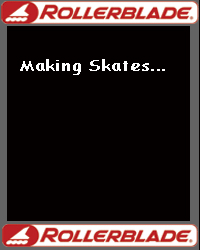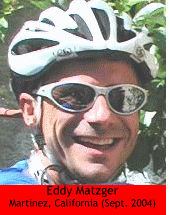 |  |  | ||||||||||||||||||||||||||||||||||||||||||||||||||||||||||||||||||||||||
| ||||||||||||||||||||||||||||||||||||||||||||||||||||||||||||||||||||||||||
Part II: Eddy Matzger Interview ... In Which the Skate Legend Talks About ...
Robert: When you got back to Berkeley after being beat by the 67-year-old skater, what did you do? Eddy: That's when I started chasing the Cal cycling team [the bicycle racing team of the University of California at Berkeley].
I could keep up with the guys for a little while, but then I would blow up. The women were a better pace for me, and they slowly accepted me. So I kept training with them. They would always start in the hills, and then they would go down and do the flats and go back up in the hills. I got a classical training by following them and seeing how they divided up their weeks. On certain days, they would go long and slow. On other days, they would do tempo [steady speed] riding. And other days, they would do sprinting. In this kind of training, you vary what you do everyday. Following the cyclists, I was getting some good training, but I still hadn't had any formal instruction. So I was hacking. Robert: What do you mean by hacking? Eddy: Skating without the proper technique, which is really important to have. Robert: How did you learn the proper technique? Eddy: One of the first things I did was to start renting figure skates on Thursday night at Berkeley's Iceland, thinking I was going to become a better inline skater by learning how to ice skate. Just coincidentally, there was a speed ice skating team that met at Iceland on Thursday night. They skated on short-track ice blades, and I started chasing them on the figure skates I was renting. After awhile, they convinced me to try some speed skates. So I got some short-track ice speed skates through Mary and Greg Wong [founders of the Golden Gate Speedskating Club in Berkeley]. Everybody gave me a lot of advice. But that confused me because everybody has there own idea about what to do to improve. My best coach at the time was a guy who would only give me one thing to work on each week. I'd keeping going back on Thursday nights, and he would give me a little critique and then give me a new thing to focus on. That way I didn't get ahead of myself. Robert: Then what did you do? Eddy: I actually went and got some coaching from Dianne Holum. She was a multiple medalist at the Sapporo Olympic games and was Eric Heiden's coach. [Heiden won five ice speed skating gold medals at the Lake Placid Olympics in 1980.] I went to the first of two camps with Dianne Holum in '89. She was training the U.S. Olympic hopeful and bringing up the youngsters on the U.S. Olympic team. She was a good coach. I thrived under her and picked up a lot of good tips on how to skate with technique and balance and timing rather than just power and fitness. She was big at unlocking a lot of huge things that made me a better skater. She straightened out my skating style. She made me skate with my hips more and use gravity --- external forces instead of internal forces and leg strength. ... She taught me to get my knees together, so that I would push with all of my weight behind every push. Robert: How important is it to keep your knees together when you skate? Eddy: If you don't have your knees together, you don't have the center of your mass over your support skate. And that will cause your ankles to collapse and pronate, which will put you on the inside edges of your wheels and tire you out. [Pronating is turning the ankles inward.] You should bring your knees together after each push and then glide and then start your next push with your knees together. You shouldn't separate your knees until the last possible second. By keeping the knees together as much a possible, you are directing all your body weight through your push. And that makes a huge difference. You get free speed you never knew you had. Robert: Did you ever consider pursuing a career as an Olympic speed skater? Eddy: Dianne Holum encouraged me to shoot for the Olympics, take the scientific approach and focus on becoming a pure ice skater. But I was still having more fun as an inline skater. It was my first love. I just saw ice skating as a way to refine my technique and become a better inline skater. And then, in '93 when I was about to make the decision about whether to go for the Olympics, I was doing the half-pipe [jumping from a ramp], and I had a pretty bad fall. I got way out over the coping and fell probably about 12 or 15 feet right onto my hip. It took me about six, seven months to get back to the point where I could skate again. Continued ... Part 1|2|3|4|5|6|7|8|9| Next >>>
| Discuss: Related Reading • Intro to The Eddy Matzger Interview
• Racing News | |||||||||||||||||||||||||||||||||||||||||||||||||||||||||||||||||||||||||
... Copyright © 2006 by Robert Burnson | ||

